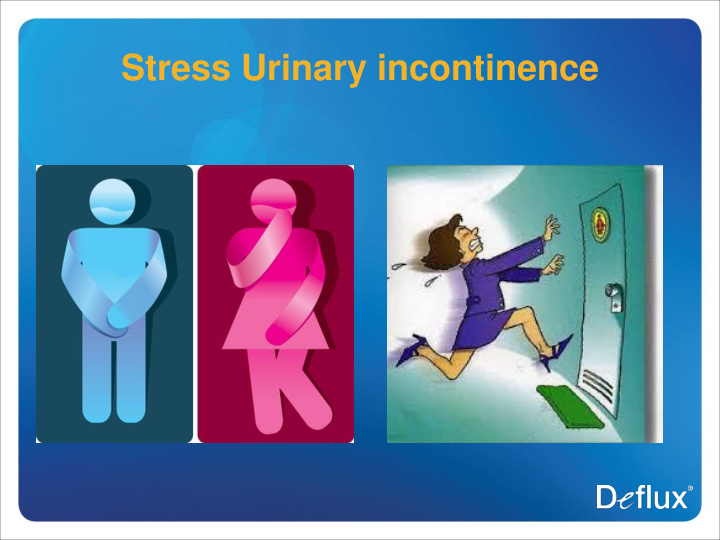



Stress Urinary incontinence
Male and Female
Inject Control • Stress urinary incontinence (SUI) is characterised by the involuntary leakage of urine, typically upon exercise, coughing or sneezing. It is a common condition that may affect 10- 40% of women across all age groups. • SUI can have a significant impact on the quality of life for people with the condition which can include social isolation and poor self- esteem. Many women just accept the condition as part of the ageing process and rely on pads and changes to their lifestyle to manage the condition. • There are a number of treatment options for SUI. Urethral bulking is a minimally invasive option and offers an effective and safe alternative to open surgery. It is an ideal first line treatment option for mild to moderate SUI.
TVT Cure Rates 85% Complication Bladder Perforation
TOT Cure Rates 85% Complication Erosion
Birch Colposuspension Cure Rates 80% Complication Haematoma
SUI
Suitability • Women who prefer a minimally invasive option • Women not suitable for a general anesthetic • Women with residual incontinence post a surgical procedure such as sling insertion • Women of childbearing age
Stenberg etal. Urethral Injection for SUI: Long term results with dextranomer/HA Int. Urogyn Journal. 2003
Materials and Methods • Direct cystoscopic placement • 4, 8 and 6 o’clock • Mean volume was 6.4mL • Age average: 67 years • Duration: 9 years
Long Term Results 6 months Long term (78mos) 5 dry 9 cured 3 worse 20 SUI pts. 4 stable 7 improved 1 worse 3 no Δ 3 remain incontinent
Safety • No evidence of any unexpected deterioration in health • No emergence of any long term safety concerns • NO pseudocysts
Chapple etal. An Open, Multicentre Study of NASHA/Dx Gel for the Treatment of Stress Urinary Incontinence European Urology 48 (2005) 488 – 494
Materials and Methods • 142 women aged 18 years + • History of SUI for 12 months • Avg age, 56 years • Mean number of deliveries: 2 • Menopausal 62%
Results: % Responders
Results
Male Incontinence Stress urinary incontinence (SUI) is an increasing problem among men, creating a huge negative impact on their quality of life. There are many risk factors, but the primary cause of male SUI is prostate surgery - in particular, radical prostatectomy for the removal of localized prostate cancer. The occurrence of urinary incontinence following radical prostatectomy ranges between 5% - 45%.
The number of men who undergo prostate surgery is constantly increasing. Over 500,000 new prostate cancer cases are diagnosed each year worldwide. Thus, the social and hygienic inconvenience that comes with SUI is also rising.
Radical Retropubic Prostetectomy Lepor et al J Urol: 2004 • 500 consecutive men • HRQOL outcomes at 3,6,12 and 24 months • All had localized disease
Post prostatectomy incontinence is often underestimated. In fact, the occurrence of incontinence experienced by patients is 2-3 times higher than that officially reported. It is important to remember that losing the ability to control urination or having to wear pads is distressing. Sometimes the fear is so intense that men refuse to undergo radical prostatectomy
Several studies demonstrate that DEFLUX is a suitable and efficient treatment for post-prostatectomy incontinence. According to one study (Alloussi ), 58% of Grade 2 patients were dry 4-8 weeks after injection, and 39% experienced a reduction in incontinence by at least one degree
Summary • Deflux can be administered under general anesthetic or local sedation • It is a minimally invasive procedure • Deflux is proven to have minimal side effects • There is a return to normal activity within 24 – 48 hours • Studies demonstrate a success rate of 74% • It does not affect more major surgery at a later stage, if required. • Requires short-acting general anesthesia • Made from materials that have been in medical use for over a decade • Deflux has been shown to remain in place for over 4 years • On average if patients require a repeat injection it is administered at 5 years 1 Cerwinka 2008; 2 DEFLUX Package Insert 2009; 3 Data on file ; 4 Stenberg 1997; 5 Stenberg 2003
Recommend
More recommend